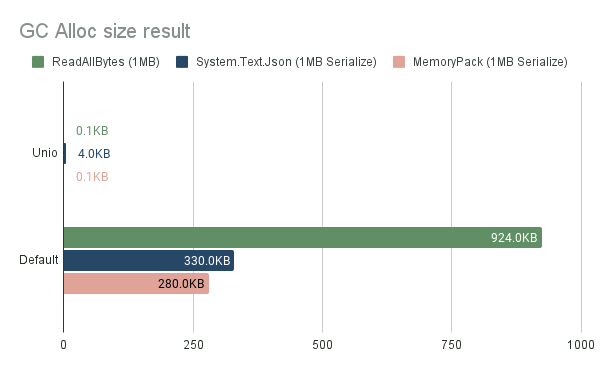Unio (short for unity native I/O) is a small utility set of I/O using native memory areas.
It provides a drop-in replacement of the System.IO.File.
| Feature | Description |
|---|---|
NativeFile.ReadAllBytes |
The NativeArray<byte> version of File.ReadAllBytes. |
NativeFile.ReadAllBytesAsync |
The NativeArray<byte> version of File.ReadAllBytesAsync. |
NativeFile.WriteAllBytes |
The NativeArray<byte> version of File.WriteAllBytes. |
NativeFile.WriteAllBytesAsync |
The NativeArray<byte> version of File.WriteAllBytesAsync |
In addition, Unio provides NativeArray extensions for interoperability with modern memory-consuming C# APIs.
| Feature | Description |
|---|---|
NativeArray<T>.AsMemory() |
Convert to Memory<T>. To easy to use as ReadOnlySequence<T>, |
NativeArrayBufferWriter<T> |
The NativeArray<T> version of ArrayBufferWriter<T> (IBufferWirter<T>). |
Motivation:
Overloading the Managed GC area in C# leads to a performance penalty for the game.
- The GC Collect phase stops all managed threads.
- The managed memory area is expanded, the application's maximum memory usage tends to increase.
Therefore, it is an important optimization to use the native allocator for memory that does not need to be handled by C#.
Unity has the ability to allocate native area memory directly, instead of using C#'s GC managed heap. https://docs.unity3d.com/Manual/JobSystemNativeContainer.html Usually it can load Assets such as Mesh, Texture, and Addressable into its native memory area, but Unio can be used to extend this use.
It is effective if data to be read/written dynamically can also be treated as Native Memory area.
One typical example is Serialization.
Modern serializers (such as System.Text.Json, MessagePack-CSharp, MemoryPack, VYaml, etc) can take ReadOnlySequence<byte> or IBufferWriter<byte> as input. Unio is designed to integrate with these.
We want to treat the deserialization result as C# memory, but the raw data before deserialization is not needed on the C# side.
You can use add git URL from Package Manager:
https://github.com/hadashiA/Unio.git?path=/Assets/Unio#0.2.0
NativeFile.ReadAllBytes / .ReadAllBytesAsync is used to read the file contents at once into Unity's Native memory area.
// Read file
// The return value is a NativeArray<byte>. Dispose when you have finished using it.
using var bytes = NativeFile.ReadAllBytes("/path/to/file");
// Read file with async
// The return value is a Awaitable<NativeArray<byte>>
using var bytes = await NativeFile.ReadAllBytesAsync("/path/to/file", cancellationToken: cancellationToken);This is just an internal, AsyncReadManager. So it works on any platform.
By default, ReadAllBytesAsync performs a synchronous wait on the ThreadPool to optimize for latency.
If you want to change this behavior, you may supply a SynchonizationStrategy argument.
using var bytes = await NativeFile.ReadAllBytesAsync("/path/to/file", SynchonizationStrategy.PlayerLoop);SynchonizationStrategy.BlockOnThreadPool(default)- Synchronous I/O on thread pools. Lowest latency.
SynchonizationStrategy.PlayerLoop- Check for completion every frame by Unity's PlayerLoop.
- It is suitable for environments where you want to wait on the main thread or where ThreadPool is not available, such as WebGL.
Note
If you are using Unity older than 2023.1, the async method will use Task<T>, not Awaitalbe<T>.
In addition, a Unio extensions of NativeArray<byte>.AsMemory() can be used to work with modern C# APIs.
using var bytes = NativeFile.ReadAllBytes("/path/to/file");
// System.Text.Json
var deserializedData = JsonSerializer.Deserialize<MyData>(bytes.AsSpan());
// MessagePack-CSharp
var deserializedData = MessagePackSerializer.Deserialize<MyData>(bytes.AsMemory());
// VYaml
var deserializedData = YamlSerializer.Deserialize<MyData>(bytes.AsMemory());Warning
Note that Memory<T> retrieved with NativeArray<T>.AsMemory() should not have a lifetime longer than NativeArray<T>.
When NativeArray is disposed, the contents pointed to by Memory<T> are also destroyed.
// Write file
var bytes = NativeFile.WriteAllBytes("/path/to/file", nativeArray);
// Write file async (only for threadpool)
var bytes = await NativeFile.WriteAllBytesAsync("/path/to/file", nativeArray);Unio.NativeArrayBufferWriter<T> is a IBufferWriter
.
It functions as a variable length buffer using NativeArray.
It is useful to use IBufferWriter<T> as input to a library that accepts it.
using var bufferWriter = new NativeArrayBufferWriter<byte>(InitialBufferSize);
// System.Text.Json
var jsonWriter = new Utf8JsonWriter(arrayBufferWriter);
JsonSerializer.Serialize(jsonWriter, data);
// MemoryPack
using var state = MemoryPackWriterOptionalStatePool.Rent(MemoryPackSerializerOptions.Default);
var writer = new MemoryPackWriter<ArrayBufferWriter<byte>>(ref arrayBufferWriter, state);
MemoryPackSerializer.Serialize(ref writer, in data);
// VYaml
YamlSerializer.Serialize(bufferWriter, data);The buffer can be obtained as a NativeArray<byte>. This can be written to a file using Unio.NativeFile.
var nativeArray = bufferWriter.WrittenBuffer;
NativeFile.WriteAllBytes("/path/to/file", nativeArray);The Unity engine provides an API that directly accepts NativeArray<byte>.
// Example of loading a yaml text from Addressable.
var textAsset = async Addressable.LoadAssetAsync<TextAsset>(assetPath);
// Unio provides a extension to get Memory<byte> from NativeArray<byte>
var bytes = textAsset.GetData<byte>().AsMemory();
YamlSerializer.Deserialize<MyData>(bytes);// Example of loading a yaml text from url.
using var request = UnityWebRequest.Get(url);
while (!request.isDone)
{
yield return req.SendWebRequest();
}
// Unio provides a extension to get Memory<byte> from NativeArray<byte>
var bytes = request.downloadHandler.nativeData.AsMemory();
YamlSerializer.Deserialize<MyData>(bytes.AsMemory());// Texture2D, for example, has the ability to get/set with NativeArray<byte>.
var data = texture.GetRawTextureData<byte>();
NativeFile.WriteAllBytes("/path/to/file", data);
var savedData = NativeFile.ReadAllBytes("/path/to/file");
var texture2D = new Texture2D(w, h, format, mipChain); // Restore
texture2D.LoadRawTextureData(savedData);
texture2D.Apply();MIT


